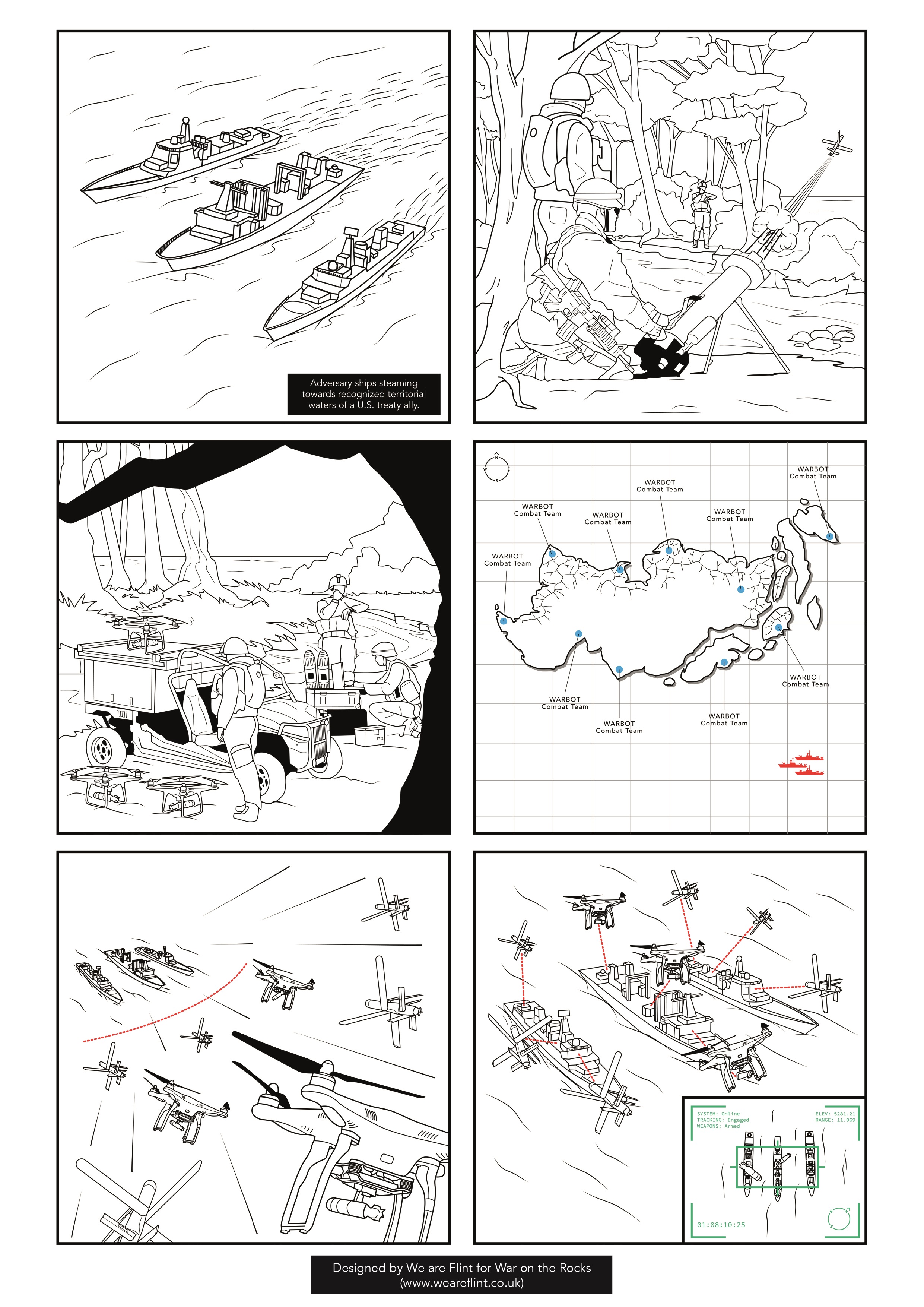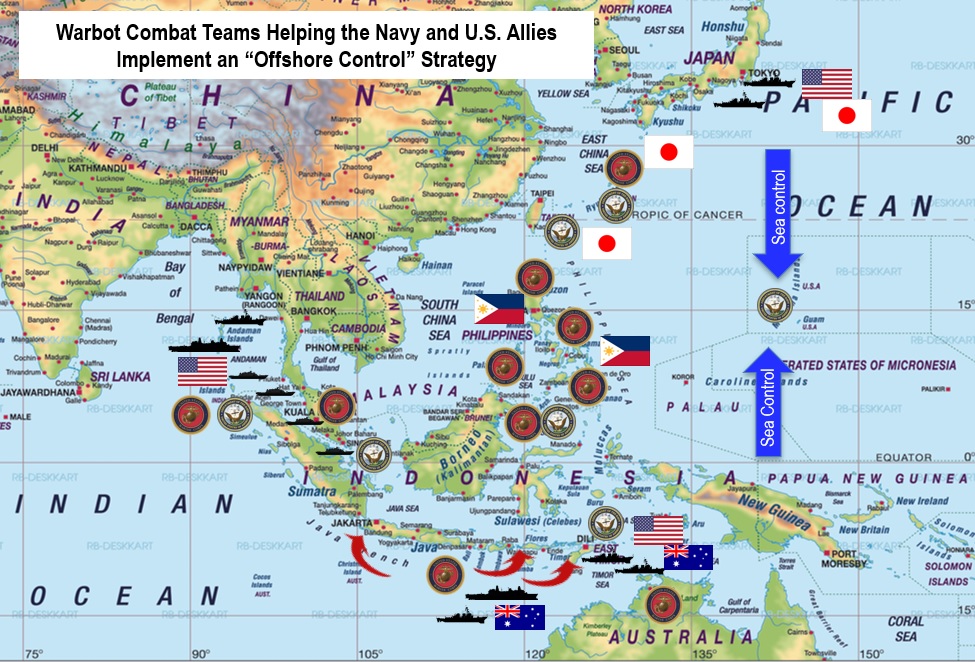How the Marines will Help the U.S. Navy and America’s Allies Win the Great Indo-Pacific War of 2025
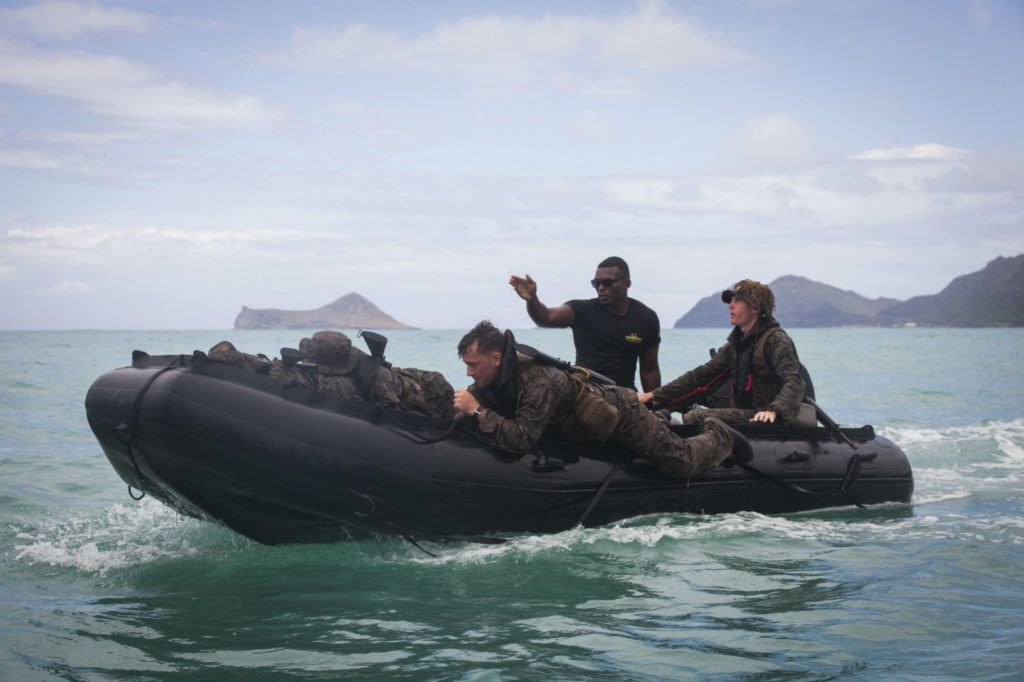
Without a dynamic body of theory, an army will follow current doctrine until it experiences … an “extinction event” — a catastrophic failure. The purpose of theory is to change current doctrine through intellect rather than the bloody empiricism of extinction.
-Robert Leonhard, Fighting by Minutes: Time and the Art of War
Would U.S. policymakers take a gamble on 30,000 amphibious troops’ lives attacking a “rock” in the South China Sea?
Many top strategic minds don’t think so and we, as U.S. marines, share their skepticism.
Yet, this hasn’t prevented the Marine Corps from continuing to articulate its intent — even in its otherwise visionary concepts — to prioritize this specific forcible entry mission. This overemphasis on conducting the increasingly unlikely large-scale amphibious assault against nuclear-armed competitors has rightfully led the Senate Armed Services Committee, top think tanks, and many observers to question the purpose of the service in the future. After all, if “two Marine Expeditionary Brigade joint forcible entry operation” remains the driving force behind the service’s procurement and force-sizing thinking and the last such assault occurred 68 years ago, then who can blame taxpayers for questioning spending more than $40 billion annually on the Marine Corps?
For those skeptical of the Marine Corps’ overemphasis on large-scale amphibious forcible entry operations, our recent article on the Warbot combat team concept — which imagines lean, lethal, survivable, and highly distributable teams of naval sharpshooters — appeared to generate some excitement. This concept argues that rapidly maneuverable teams of marines properly trained, educated, and equipped with artificial intelligence-enabled, autonomous weapons systems and loitering munitions can support naval maneuver to project power and enable sea control. Since publication, we’re grateful to have received encouraging feedback from marines and sailors, as well as from soldiers, airmen, and many others across the national security community. These voices have been pleased to see the marines making serious efforts towards the provision of innovative, affordable solutions that are cost-imposing and dilemma-creating for adversaries, while simultaneously enabling the U.S. Navy, the rest of the joint force, and U.S. policymakers to reassure our allies and partners. Many are also hopeful that something like the Warbot combat team concept represents the future of the Marine Corps, given the value they see in this concept across multiple combatant commands and the range of military operations. But they have also asked for more details.
Thus, the purpose of this article: a dispatch from four marines to our naval service leadership and the American people sharing ideas on how the Marine Corps can help the Navy, the joint force, and our allies win by averting — or, if necessary, succeeding in — the speculative Great Indo-Pacific War in 2025. This can be accomplished by maximizing the use of lethal, coordinated, and swarming Warbot combat teams. These distributed marines will be able to strike adversaries from every direction, both within the littorals as well as at stand-off range. In so doing, they’ll enable friendly naval maneuver, reassure allies, create countless “no win” dilemmas for adversaries, and buy space and time for U.S. policymakers.
Warbot Combat Teams: Means in Execution
The Marines and their Warbot combat teams can serve as an important means to strengthen America’s alliance architecture and deter revisionist powers in support of an international order favorable to American interests. Simultaneously, these units can increase the naval service’s ability to counter developing threats, extend decision-making time and expand maneuver space available to policymakers. Ultimately, these means provide the U.S. military an essential pathway to avoid “becoming a paper tiger.”
As we write this article, around 23,000 marines are already forward-deployed west of the International Date Line. They operate shoulder-to-shoulder with U.S. allies and partners in Japan, Australia, South Korea, and the Philippines. They are also embarked aboard U.S. Navy ships as part of elements such as the 31st Marine Expeditionary Unit. These 2,200 embarked marines operate across Indo-Pacific Command. They are also frequently reinforced by other Marine Expeditionary Units, who train, assist, and reassure allies and partners in countries such as Thailand, Singapore, India, Malaysia, and Indonesia. Collectively, these marines serve as vital components of the National Defense Strategy’s four-layered operating model: “contact,” “blunt,” “surge,” and “homeland.” Specifically, they are critical in the “contact,” and should an adversary’s aggressive actions require, “blunt” layers. Forces in the “contact” layer are “designed to help us compete more effectively below the level of armed conflict,” whereas those in the “blunt” layer are to “delay, degrade, or deny adversary aggression.” Our Corps’ senior leaders have explained that to operate effectively in these layers “Marine forces must be combat-credible and oriented on warfighting to provide credible deterrence.”
Most of these 23,000 marines’ “contact” layer actions go unnoticed. Beyond daily interoperability training and assurance exercises across the Indo-Pacific, not enough people know that these marines also execute critical strategic missions such as coming to the aid of treaty allies in need. For example, consider how marines, as part of the Navy-Marine Corps team, helped respond to the recent natural disasters in Japan and the Philippines. Think also about the intangible value of the thousands of forward-deployed marines in Japan in 2014 when amidst tensions between Beijing and Tokyo over islands in the East China Sea President Barack Obama stated, “Let me reiterate that our treaty commitment to Japan’s security is absolute, and Article 5 covers all territories under Japan’s administration, including the Senkaku islands.”
Specific to the Warbot combat team concept, however, what’s most important about these marines is their near-term potential to enable and provide more distributable and survivable capacity in the nation’s “contact” and “blunt” layers. This potential enables them to provide disruptively more precise, lethal, logistically feasible, and ultimately effective deterrence. In so doing, they would undoubtedly raise any potential adversary’s escalation costs.
How would this Warbot combat team concept differ from what presently exists? Warbot combat teams would be far more lethal, relevantly-postured, and maneuverable than what the Marine Corps fields in Asia today. Deterrence is based on a balance between threat capabilities, communication of those threats, and credibility for follow-through, should actualization of the threat be warranted (based on the aforementioned communication). Thomas Schelling focused on the communication portion of deterrence, the bargaining, whereas Clausewitz considered “a threat [as] the possibility of future military action based on the disposition of the forces at that time.”
Should an adversary illegally breach a treaty ally’s 12-mile territorial maritime boundary or contemplate conducting aggressive actions against partners, Warbot combat teams could provide a credible strike capability simultaneously reassuring the ally or partner, just as Randall G. Schriver, the U.S. assistant secretary of defense for Asia and Pacific security affairs, recently emphasized America would do. By helping to uphold international law and ensure freedom of navigation for civilian and military vessels, Warbot combat teams would help to provide another “essential victory for U.S. and allied arms and the rules-based international order they defend.”
Whether embarked on amphibious shipping or on land in Japan, Australia, Guam, or elsewhere, these Warbot combat teams — with minimal logistical requirements and superior fires capacity relative to traditional concepts — are exactly what is called for in the National Defense Strategy: lethal, agile, and resilient. Additionally, should Warbot combat team reinforcements be required to “blunt” any potential adversary actions that run contrary to U.S. and allied interests, the below graphics illustrate how quickly platforms such as the Marine Air-Ground Task Force’s (MAGTF’s) MV-22s and KC-130s can get them there.
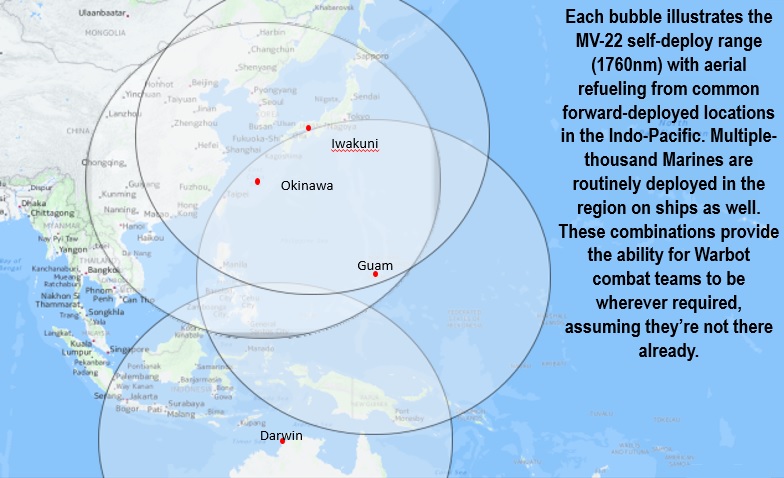
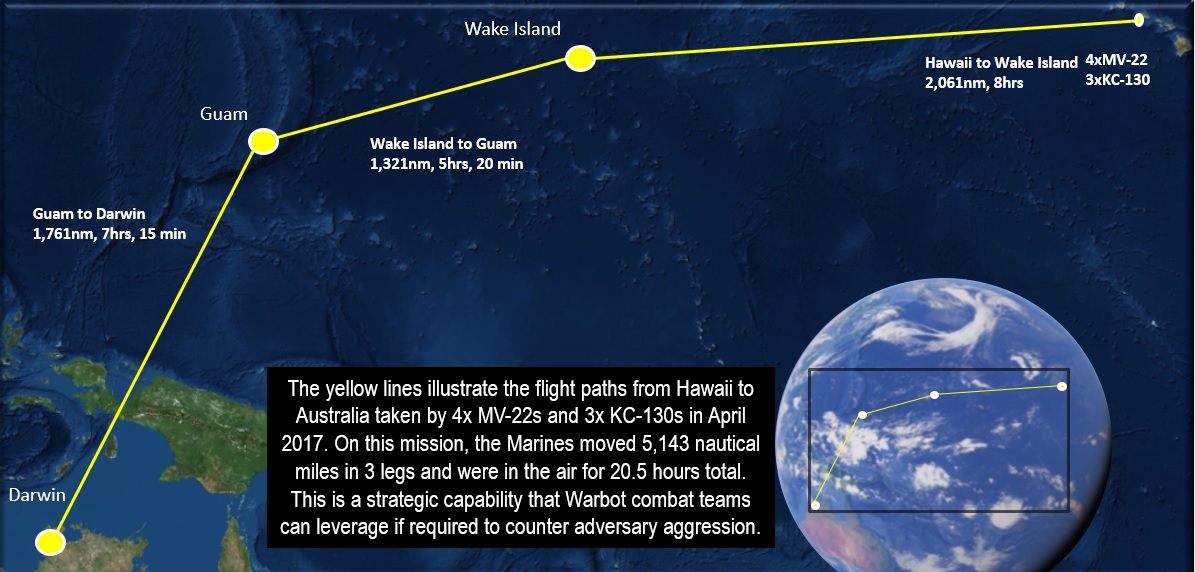
Imagine a geo-strategic crisis where a peer competitor sought to seize part of a treaty ally or partner’s territory, which possesses undersea network nodes. 223 undersea cable systems are responsible for over 99 percent of all transoceanic digital communication. Of the 685 undersea cable network nodes — where the cables transition between land and sea — 366 are located on islands, many of which are located in the Indo-Pacific region.
From U.S., allied, and commercial surveillance capabilities, the joint force maritime component commander receives information that many thousand adversary assault troops, embarked on naval shipping, are sailing east at approximately 16 knots. This adversary force is 300 miles from its expected objective. At this point, the joint force maritime component commander has around 20 hours to develop and implement a plan to blunt the attack.
A Warbot company — composed of around 200 marines trained to operate in more than 12 separate teams — is already on the ground in the country where the attack is expected. The joint force maritime component commander orders the marines to move into positions to blunt the adversary assault. The marines, partnered with allied troops who have trained to this scenario in exercises alongside U.S. marines, move via organic all-terrain vehicles and local transportation to assume these positions three hours later. With more than 100 loitering munitions, located in dense vegetation, this Warbot enabled, airfield-less mini-MAGTF is prepared to sense, swarm, and if necessary, neutralize adversary naval vessels at ranges out to multiple dozen miles. Additionally, this unit has a limited number of platforms that range out to 500 miles while carrying up to 20-pound payloads.
Simultaneous with this mini-MAGTF’s actions, the joint force maritime component commander orders three more Warbot companies to insert into an offensive defense-in-depth akin to a forward-postured Clausewitzian attack-defense. MV-22s fly one of these units in from a ship located 500 miles away and arrive three hours later. A second Warbot company inserts via missile-capable fast attack craft from a separate ship and is in position within a similar timeline. This company is prepared to blunt the adversary attack on land or from their fast attack craft. The third Warbot company launches from a forward-site in MV-22s and covers 1,200 miles to arrive five hours later.
The joint force maritime component commander, along with U.S. and allied policymakers, now has a force of more than 1,000 personnel on the ground, armed with nearly 1,000 loitering munitions, as well as bayonets, grenades, rifles, machine guns, rockets, mortars, and long-range missiles. This force is prepared to engage the adversary from every direction, at ranges as far out as 500 miles. Moreover, due to the innovative efforts of young logistics marines, this force can also 3D print hundreds more loitering munitions from locations near their defensive positions. Additionally, autonomous aircraft and boats can deliver these weapons directly to the distributed Warbot combat teams.
At this point, the adversary has 10 hours remaining on its movement across the ocean. American and allied policymakers communicate to the threat country’s leadership that a coalition force is in position and prepared to uphold international law and U.S. mutual defense treaty obligations.
What do you think the enemy would do next?
The Changing Character of Deterrence
Let’s compare the deterrent value of the Warbot combat team concept with the deterrent value of nuclear weapons. Nuclear weapons are the “break-glass-in-case-of-emergency” weapon. When the switch is flipped, all bets are off. By design, the violence is extreme and existential. Warbot combat teams, however, properly deployed and communicated, will not only help make sure that glass need not be broken, but also provide a fire extinguisher when needed, just as marines have done throughout history. They are not meant to substitute for follow-on “surge” forces, but they could quell the most likely crises. And in so doing, they critically help the Navy and reassure allies and partners while buying time and space for decision-makers to implement policy options. Depending on the crisis, the policy option might be similar to the scenario just described, Patrick Cronin and Hunter Stires’ maritime counterinsurgency campaign, Elbridge Colby and Jonathan Solomon’s “deterrence by denial,” or perhaps it might be executing T.X. Hammes’ proposed theater-wide “offshore control” strategy. In the latter case, dozens of Warbot combat companies already present within the “contact” layer would move into positions to help the Navy and U.S. allies and partners isolate the Western Pacific to buy space and time for policymakers.
The power of time and space, especially in this digital, global, interconnected, and interdependent world, is precious. Just as the stock market is seeking to exploit the millisecond, buying policymakers extra time to think through maneuvers, diplomatic responses, and other political engagements is paramount. Add more algorithms to the equation and the value of time continues to increase no matter the tyranny of distance. The already forward-deployed Warbot combat teams would enhance credibility and deliver precise capabilities across the theater when and where needed without requiring mobilization of the entire Marine Corps. Furthermore, this alleviates undue burdens from the Navy and remainder of the joint force. Moreover, it buys the required time and secures the key maritime chokepoints required to mobilize the “surge” layer force should it be warranted.
Comparing the Warbot combat team concept with that of nuclear weapons, we see a consistency with communication, a difference in capability, and an increase in credibility. Communication is in line with the National Defense Strategy’s “transparency and non-aggression” guidance and relies on our senior leaders to explain what the Marines, the Navy, and the rest of the joint force will (and are willing to) do. While nuclear weapons are credible — given the object lessons of Hiroshima and Nagasaki — they are somewhat less effective as adversaries might not think it likely that the United States will use them in scenarios like the one posed in this article. In other words, in most escalation scenarios, they involve way too much bang for their buck. And that’s where the Warbot units can come in. Nuclear weapons are eminently lethal and resilient, but have limited agility.
Today, Warbot combat teams could provide a lethal, agile, and resilient option to deter, and wage war, including those that unfold below the traditional conflict threshold. The capability of Warbot combat teams is different in degree, but not in kind, which is why they are an added step in the escalation ladder. Moreover, the ability to discriminate (with less suffering, employed when militarily necessary, and with appropriate proportionality) increases credibility, since we are more likely to use them should we need to.
Top 10 Actions Required to Make Warbot Combat Teams Real
While the Warbot combat team concept has great potential to transform how marines can help the Navy and U.S. allies and partners, achieving this potential requires key rudder changes to current Marine Corps priorities. The required shifts are described below:
- At a deep, philosophical level, heed the Senate Armed Services Committee staff director’s recommendations shared at the recent Aspen Strategy Group: stop prioritizing “small numbers of exquisite, expensive, manned, hard-to-replace systems” and instead embrace “a large number of inexpensive, unmanned, expendable, autonomous systems that can survive in the new electronic battlespace and overwhelm any potential adversary.”
- Embrace regular senior leader interactions with America’s top technology companies in Silicon Valley, Austin, Boston, and elsewhere to help explain how the Marine Corps will ethically employ artificial intelligence-enabled systems to help keep peace, to save lives, and to deter war, unlike China which is using them to surveil, repress, censor, and bully its own citizens and those from other countries.
- In conjunction with the Navy, the rest of the joint force, inter-agency partners, and key allies and partners, develop new doctrine, organizational headquarters’ structure, and training standards to ensure widespread understanding of Warbot combat team capabilities, regular evaluation, and daily integration across the naval force.
- Double-down on emerging efforts to prioritize selecting, training, educating, and retaining a more mature and uniquely skilled close combat small unit leader that will serve as the Warbot unit foundation. Such efforts have been discussed in the Corps for decades. As per Secretary Mattis’ Close Combat Lethality Task Force intent, it’s time to execute.
- Change this foundational unit’s organization, equipment, and training in accordance with the service’s recent Sea Dragon experiment recommendations. Any notion that these marines are traditional “grunts” must be erased immediately.
- Transition lethal aerial loitering munition systems’ experimentation efforts to widely fielded capabilities across the Corps. Also ensure that this fielding includes artificial intelligence-enabled lethal autonomous weapon systems that increase precision, decrease response time, and minimize human error for rapid target sorting and response with employment options as described in another War on the Rocks article.
- Ensure that the 2019 Marine Aviation Plan reflects this priority. It’s time for the service’s traditionally manned aviation community to start to seriously embrace small, remotely piloted and autonomous aircraft. Less than 1 percent of the 2018 Marine Aviation Plan even acknowledges these capabilities and when doing so references dated technologies. “Authorizing” concepts is a start, but without commensurate appropriations, these changes will wither starved for funding fuel.
- Double-down on the emerging Sea Dragon II logistics experimentation efforts, with a specific focus on determining loads, maneuver, and capability sets that enable distributed and rapidly maneuverable Warbot units.
- Invest in a dedicated, fused integrated naval network to help enable the sensing, cueing, and command and control of these units and weapon systems.
- Strengthen the Marine Corps’ commitment to fostering and empowering bottom-up innovation and grassroots collaboration like that found in Ender’s Galley and the Marine Makers. These efforts cultivate intellectual curiosity, critical thinking, and a culture of life-long learning along with technical literacy. Marines are the Corps’ exquisite systems and require investment in them as such.
“America’s Military Has No Preordained Right to Victory on the Battlefield”
Nearly 70 years ago, the Marine Corps realized the service was at a decisive moment. Nuclear weapons had changed warfare. If marines were going to “remain the most ready when the nation is least ready,” major changes were required to how the service manned, trained, equipped, and employed its units. Additionally, the Marine Corps recognized it would have to fundamentally change its close integration and support for the Navy. In short, the marines were at another “Fullamite” moment. And similar to Kori Schake’s observation that “Good strategists also ought to be desperate paranoiacs,” the Marine Corps is best when it taps into the creativity generated from such neurosis. In response to these realizations, the Marine Corps developed revolutionary concepts, like vertical envelopment and close air support that successfully paired with novel capabilities critical for success during the Korean War. They provided for the nation what B.J. Armstrong describes as “The Answer to the Amphibious Prayer.”
To ensure that the Marine Corps can help the Navy, joint force, and U.S. allies and partners succeed in the Indo-Pacific in the future, the service is now in need of a 21st century answer to the current amphibious prayer. Fortunately, the service is already taking key steps towards the answer. Full implementation of the Warbot combat team concept is an essential next step. This mini-MAGTF concept will allow forward-deployed marines in the “contact” layer to reassure allies and partners while serving as on-call “shields” should policymakers require lethal force to “blunt” adversary aggression. Simultaneously, if ever required, these marines provide policymakers time to “surge” the larger naval and joint force “sword.”
Scott Cuomo is a Marine Infantry Officer and MAGTF Planner currently participating in the Commandant of the Marine Corps Strategist Program at Georgetown University.
Olivia A. Garard is a Marine Unmanned Aircraft Systems Officer. Additionally, she is an Associate Editor for The Strategy Bridge and a member of the Military Writers Guild. She tweets at @teaandtactics.
Jeff Cummings is a Marine Infantry Officer and currently serves on the faculty of the Expeditionary Warfare School, Marine Corps University.
Noah Spataro is a Marine Unmanned Aircraft Systems Officer currently serving as the commanding officer of VMU-1.
The opinions expressed are those of the authors alone and do not reflect those of the U.S. Marine Corps, the Department of Defense, or any part of the U.S. government.


